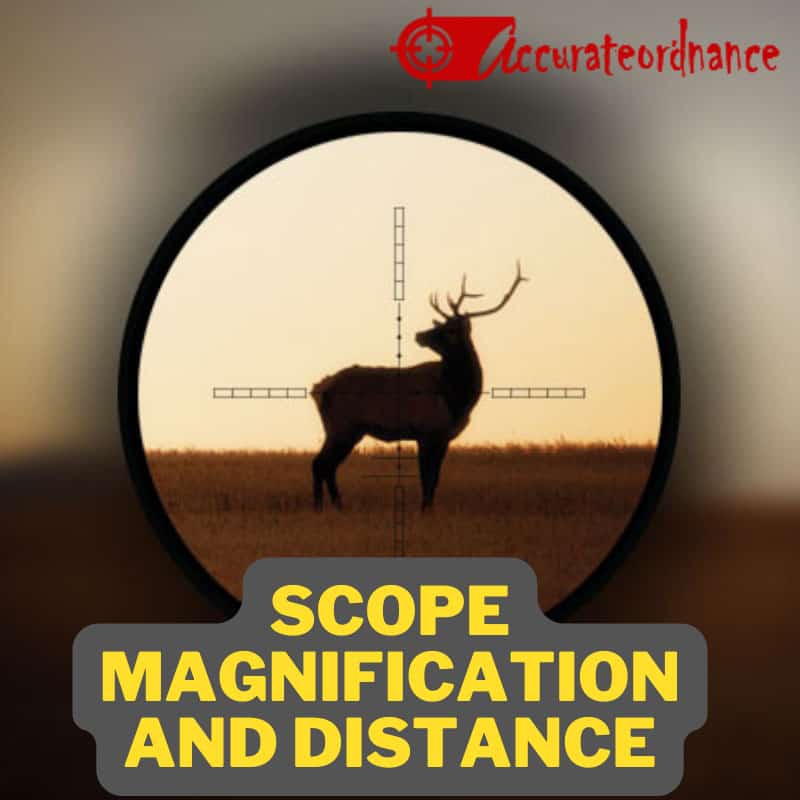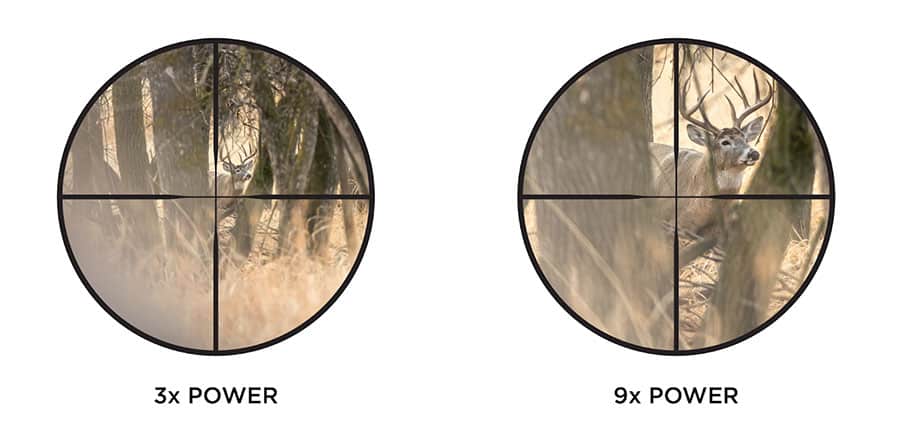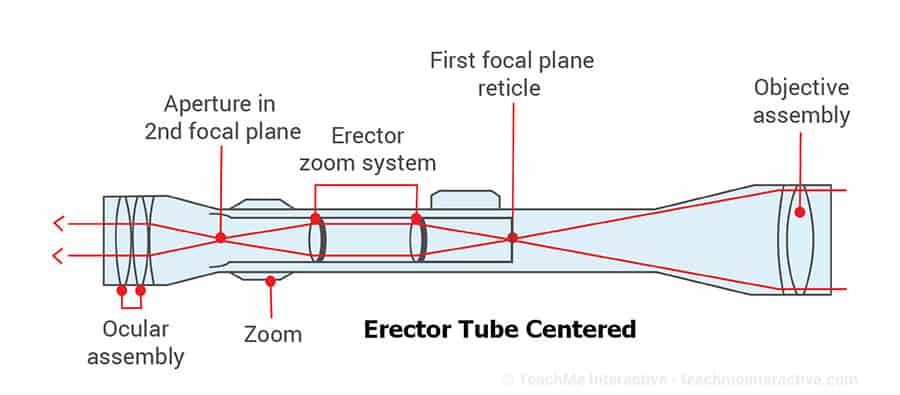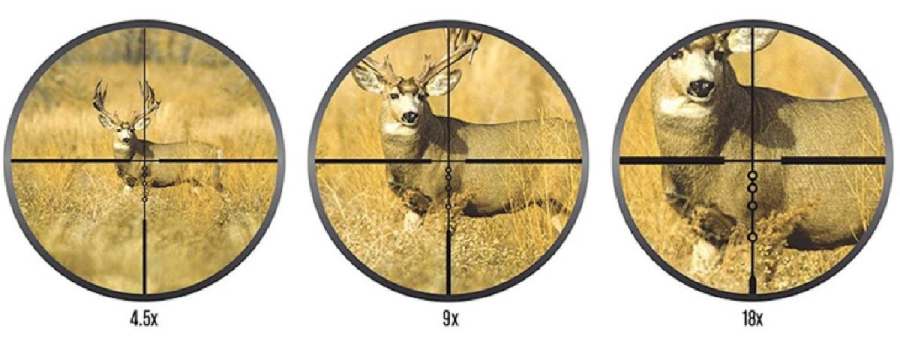If you’re new to the rifle scope world, you might not know that magnification and distance are actually very closely related. While magnification is something that is on your scope and distance is something that more relates to your target, the image distance will be greatly affected by the magnifying power. An objective lens that has a higher magnification will be better at seeing distant objects, while a shorter focal length will prove to have a shorter distance range.

In order to understand the relationship between the two, you must first understand how magnification works on a rifle scope.
Typically, all scopes will come with some sort of identifying number or specification that will tell you the magnification range. That number will look something like 8.5×50. Using this example number, we can tell that the rifle scope has a set magnification level of 8.5 times and that the objective lens is 50 millimeters in diameter.
Read more about meaning of number on rifle scope
On a variable scope, the magnification equation will look a little different. For a variable scope, it will look something like 4.5-25×50. This means that the scope has a range, and that the magnification increases from 4.5 times up to 25 times. Like before, this scope also has an objective lens that is 50 millimeters in diameter.
What is Magnification?

Let’s start with what magnification actually is. The angular magnification of a scope is a physical characteristic. This is determined by whether you have a thick or thin lens, a convex lens or concave lens, the curvature of the lens, and how big the magnifying glass is.
Depending on how your linear magnification works, there’s actually some different equations that will determine the magnifying power and its function. For example, you might come across a scope that has been created using a thin lens equation because of the physical thickness of the glass. There’s a different lens formula that will define and create the properties of a certain type of lens just purely based off of their physical characteristics.
The main component of all the different types of lenses inside of a scope (diverging lens, converging lens, and second lens and first lens) all serve 3 main purposes:
- Image formation and magnification: the objective lens absorbs a light ray and creates a refractive index that reflects the light back to create the virtual image of the real image target. This is where the second lens may come in to assist in making the final image and the focal point so the shooter can see it.
- Inverting the magnified virtual image: the image formation done by the objective lens is actually inverted at this stage. There’s two lenses, almost like a concave mirror and a convex mirror, that act like a mirror to return the image to make sure it is the right side up. The spherical mirror like lens is what makes the image viewable for your eyes. Keep in mind that a rifle scope is very similar to a compound microscope, which a lot more people will be familiar with.
- Image focusing: another lens called the ocular lens brings the virtual image into focus so you can see it clearly through your optic. The diameter of this lens is what determines your eye relief. Eye relief is how far you can see the focused scope image, which is also known as focal distance.
The Magnification Equation

There is something called the magnification equation. This equation is what determines the image size that you see through the scope and what the distance is of the magnified image. Magnification itself is basically just the ratio that comes from the focal length of the objective lens and the focal length of the ocular lens.
What this means is that the magnification equation will tell you how your image size or image height will be different from the actual physical object height or size. For example, an object that is viewed at 3 times magnification will look like it is 3 times closer to you than it actual is. An object that is 300 yards away will look like it is only 100 yards away when you look at it with the 3x magnifying power.
While this equation will explain how the target looks closer, it also accounts for how big the target will look. When you use magnification, not only will the target appear closer, but nearly double in size as well.
Magnification Limitations
While magnification is a great tool, there’s also some distortions and other issues that will come along with it.
Chromatic Aberration
This phenomenon occurs when you look through your scope and see an image that is blurry on the edges or lined with a purple color. This issue will occur when your scope absorbs different rainbow colored light. Since the light ray will come through the lenses as a different wavelength depending on the color, each one will interact differently with the prisms of the lenses inside of the scope.
This reaction makes white light break up into different colors, which then causes the purple color or “fringing” that you might see around your images. While this happens to all prisms, it will get much worse when magnification is involved.
Curvature Field
If your scope has low magnification, you might experience blurry image edges. When you’re using the lower magnifying powers, the focal point is shaped more like a sphere than a flat plane. This means that the center of your target is going to be the sharpest focal point, while the edges will start to fade into some blurriness.
Spherical Aberration
This form of aberration is caused by the shape of the lenses and how they reflect light rays. What this means is that as the light passes through the lens, it will become more bent at the edge of the lens rather than in the center because of the shape of the lens.
The light that is at the edges of the lens will be on a different focal point than the rays that are coming through the center. Just like field curvature, this issue will have the same blurry edges effect. It will also get worse as your magnification increases.
Field of View
The field of view is how far left to right and up and down you can see when you look through your scope. A wide field of view will allow you to see a lot of area around your target. There’s actually a way to calculate your field of view: divide your objective lens diameter by the magnification level. As you increase your magnification, the field of view is going to decrease in a ratio since it’s directly related to the magnification level that you are currently using. It will always decrease in a proportionate manner because the objective lens is a fixed focal length lens. This means that the higher the magnification, the less you’ll be able to see.
Dimming
When you’re using a scope that starts stacking multiple, thicker lenses, then the amount of light that is actually being transmitted, rather than just absorbed or reflecting, starts decreasing. Especially when higher magnification lenses are present, your image through the scope will get dimmer as your magnification rises.
Distances and Recommended Magnifications

Now that you understand how magnification works and how it depends on distance to calculate, let’s talk about some recommended magnification ranges for certain common rifle shooting distances.
100 Yards
Typically, when choosing a scope, you also want to consider things like caliber and the type of weapon that you’re going to be shooting. When it comes to magnification, if you plan to be shooting from 100 yards, a magnification of 3x has been found to be more than sufficient. If you want an extra vision boost or a higher magnification, you can go for a scope that has a fixed or variable range of 3x-9x. This will give you good vision but also not bog down your rifle too much with weight and distortion unnecessarily.
200 Yards
This is the most common hunting distance currently in the world of shooting. For 200 yards, usually a range of 3x-9x still works, but the 3x magnification might cut a little short in some cases. So, it’s best to start at 4x for a 200 yard target range.
300 Yards
This is where the distance starts becoming a little extreme for most shooters. When you start to get into the 300 yard range, you most definitely need to start with a minimum of 4x-12x of a magnification range.
400 Yards
This is definitely considered long range when it comes to hunting or shooting. However, 400 yards is still pretty much classified about the same as 300 yards. So, for 400 yards, you’ll want to go for a 4x-12x range.
500 Yards
Here begins a whole new level of extreme long distances. While it might be a normal thing for a competitive shooter, most people never take game shots upwards of 300 yards, let alone 500. For this range, you’re going to have to go big or go home, which can start becoming a bank buster. For 500 yards, you’ll need a 6x-18x range of magnification.
1000 Yards
This is the most extreme of the extreme. 1000 yards is typically way out of the range of most shooters, even the long range competition shooters. But, if you’re planning to venture into that range, you’ll need the right magnification. In order to be precise at 1000 yards, you’ll need 12x-24x magnification range.
| Distance | Magnification Needed |
| 100 yards | 3x-9x |
| 200 yards | 4x-9x |
| 300 yards | 4x-12x |
| 400 yards | 4x-12x |
| 500 yards | 6x-18x |
| 1000 yards | 12x-24x |
FAQs
What magnification do I need for 100 yards?
You’ll need a minimum of 3x.
What magnification do I need for 200 yards?
You’ll need a minimum of 4x.
What magnification do I need for 400 yards?
You’ll need a minimum of 4x.
What magnification do I need for 500 yards?
You’ll need a minimum of 6x.
What magnification do I need for 1000 yards?
You’ll need a minimum of 12x.
Is 5x too much for hunting?
No. 5x can be used anywhere from 100 yards to 400 yards to make any shot. This is the most common hunting distance.
How far can you see with a 3-9×40 scope?
50-300 yards.
How far can you see with a 4-12×50 scope?
100-500 yards.
What range is a 6-24×50 scope good for?
Up to and above 400 yards.
How far can you shoot with a 4-16×50 scope?
Further than 400 yards.
How far can you see with a 10×40 scope?
300-500 yards.
References

Mike Hardesty is a published freelance gun writer. He also possesses specialized expertise in rifle scopes With dozens of articles and reviews published in Pew Pew Tactical, Snipercountry.com, and TTAG (The Truth About Guns), Mike is considered a firearms expert. His special area of expertise is handguns.
Mike is a long-time shooter. He has been punching paper targets, taking deer and other game and shooting at competitions since about 1975. Other related pursuits include reloading and bullet casting. He currently reloads for over 10 calibers, both handgun and rifle. His reloads, particularly for 9mm, were in great demand during the height of the ammo shortage among family and friends. He donated hundreds of rounds to informal shooting sessions. He was quoted as saying “I do not sell my reloads but I sure will help my guys shoot ’em for free!”. He has a few cherished firearms that he has inherited or otherwise procured — those are his favorites.
He earned B.S. and M.S. degrees from Indiana State University in 1974-1975.
He’s a firearm experts and is the founder of mhardesty.com.
